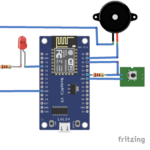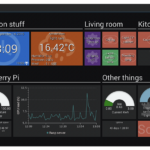The Internet of Things (IoT) is a network of billions of smart devices working with countless Internet-enabled digital services. One such service is weather forecast. Weather APIs integrate weather data with smart devices, websites, and online platforms. Several IoT applications use weather data, such as smart clocks, temperature control systems, as well as travel and fitness devices.
Most weather APIs provide a comprehensive set of features that let developers alter the behavior of their apps or applications according to user preferences or historical trends. This gives businesses significant flexibility when developing creative methods to interact with the weather data the API service provider gathered, launching timely updates as needed.
 Different weather APIs mean different features and costs. Making the ideal choice depends on what you’re looking for. In this article, we’ll discuss some of the top weather APIs, both free and paid, so you can find one that fits your needs.
Different weather APIs mean different features and costs. Making the ideal choice depends on what you’re looking for. In this article, we’ll discuss some of the top weather APIs, both free and paid, so you can find one that fits your needs.
What is a weather API?
A weather API (Application Programming Interface) is a service that provides access to weather data, such as temperature, precipitation, humidity, wind speed, forecast information, and other meteorological details. These APIs let developers integrate weather information into their applications, websites, or IoT devices.
Weather APIs gather information from various sources, including satellites, radar, weather stations, and other global and local meteorological data providers. The collected data is processed and analyzed using advanced algorithms and sometimes artificial intelligence (AI) to provide accurate and up-to-date weather forecasts and historical weather data.
Then, the processed weather data is made available through different API endpoints. An endpoint is a specific URL representing a particular aspect of the weather information, such as current weather, forecasts, historical data, etc. Developers send requests to these endpoints to retrieve weather data, typically over the web.
The API then responds with the requested information, typically in a format like JSON or XML, which can be easily used in the developer’s application. The received data can then be integrated into various applications, allowing for functionalities such as displaying the current weather, providing weather-based recommendations, or triggering actions in IoT devices based on specific weather conditions.
API key
To authenticate a request when connecting an API to a project or application, you must have a key, generated when signing up for a weather API. The key is used in the software application code or devices interacting with the weather API. With this app key, you can examine metrics based on your API calls.
Best weather APIs
Here is a list of some of the best weather APIs for mobile and IoT apps.
1. WeatherAPI.com
2. OpenWeatherMap
3. Meteostat
4. Stormglass API
5. Weatherbit API
6. The Weather Company
7. AccuWeather API
8. Weather Embed
9. Visual Crossing Weather
10. Tomorrow.io API
WeatherAPI.com is designed for developers and provides a comprehensive weather and geolocation API with a user base of more than 310,000 globally. It offers many APIs covering sports, time zones, currency API, map API, geolocation, real-time and historical weather forecasts, air quality data, bulk requests, IP search, and astronomy. It offers 14-day daily, hourly, and 15-minute interval weather forecasts, future weather predictions (up to 365 days ahead), and historical weather data from 2010, covering numerous cities and towns.
WeatherAPI also provides access to real-time global weather stations and high-resolution weather points ranging from 1 to 11 km for various intervals and data types. Users can sign up for free, upgrade anytime without long-term commitments, and receive a scalable infrastructure with 99.99% uptime. All data is provided in lightweight XML and JSON formats, with bulk request capabilities for easier integration. The response time is typically 200 ms. The API employs AI and machine learning to select the most reliable weather data from their sources.
OpenWeatherMap is one of the most popular choices for weather data, offering a suite of weather-related services through its API. Its One Call API provides various data, such as minute forecasts for hourly forecasts up to 48 hours, daily forecasts for up to eight days, and government weather alerts. It also includes weather data for any timestamp over 40 years and a 1.5-year forecast. Users can make 1,000 API calls per day for free, with the option to pay for additional calls beyond the daily limit.
This API provides real-time weather data for any location in JSON, XML, and HTML formats. Additionally, it offers hourly forecasts for four days, daily forecasts for 16 days, and climatic forecasts for 30 days in JSON and XML formats. OpenWeatherMap also provides a five-day forecast with a three-hour step, a Road Risk API for weather conditions along specific routes, and a Solar Irradiance API for solar data and energy prediction.
Meteostat JSON API offers long-term climate data, historical statistics, and weather observations for hundreds of locations across the globe. It is one of the most prominent open weather and climate data vendors. The weather data can be queried by weather station or geolocation with options to filter by date and other parameters. It uses RapidAPI for simple integration and management, providing a URL base for all endpoint calls.
Users must sign up for an API key through RapidAPI, where Meteostat offers a freemium model allowing 500 free calls per month. They also offer paid plans with higher quotas. Authentication for the API requires sending the X-RapidAPI-Key header with each request. The API returns JSON objects containing metadata and the actual data, supporting HTTP GET requests with various status codes for debugging.
Stormglass API is a professional global weather service offering high-resolution forecasts, relied upon by industries involved in weather routing, autonomous ships, agritech software, and green energy production monitoring. Stormglass offers not just standard meteorological information but also maritime information (weather, tides, chemical compositions), renewable energy information (wind, solar indices), and agriculture information (soil moisture, surface temperature). It features Storm Glass AI, an intelligent global grid that automatically selects the best weather source to ensure performance optimization for users, eliminating the need to handle multiple weather sources.
For developers, StormGlass API offers comprehensive documentation, which includes information about all parameters, sources, code examples, and guidance for integration. The API provides a free tier with limited access, which allows users to make a certain number of API requests per day at no cost. However, for higher volumes of requests or access to more advanced features, paid plans are available.
Weatherbit API is commonly used by businesses and developers, offering global meteorological data for today and the future. The data is collected from over 50,000 weather stations and other sources, including satellites, radiosondes, and lightning networks. Weatherbit’s Forecast API provides high-resolution and high-precision weather forecasts derived from global and regional weather models, improved with machine learning methods for bias correction.
The forecasts come from data with a spatial resolution of 1-13 KM globally and machine learning methods help select the most accurate models. This API provides hourly forecasts up to 120 hours, daily forecasts up to 16 days, and minute-by-minute precipitation forecasts for one hour. Some specific forecast APIs include 16-day, 240-hour, and hourly or one-minute forecasts. It lets users observe weather trends over time, build dynamic maps, and set up bespoke alarms depending on predetermined criteria. There are subscription plans with a free tier option, which includes limited access to their weather data.
The Weather Company is part of IBM’s Environmental Intelligence Suite. The Weather Company Data API offers a comprehensive set of weather data services and tools for various applications. The documentation is managed by Datamensional, which compiles and distributes it for ease of access.
This API offers weather conditions, accurate hourly forecasts, real-time alerts, time-series observations, and historical weather data. It also provides enterprise-level hourly forecasts, 15-minute forecasts, nowcasts, detailed precipitation forecasts, 15-day forecasts, marine forecasts by ECMWF, and data for analytical tooling. The weather data can be visualized on a dashboard, along with historical daily summaries, hourly historical conditions, and on-demand current conditions.
This weather API supports various forms of data visualization, including geoJSON for mapping visualizations, though the Core package uses tiled PNG. Additionally, it provides location services utility APIs for point and search, near, and boundary functions. A free trial is available for those interested in first testing the service. After a trial period, a subscription is needed to continue access.
AccuWeather API has become relatively popular thanks to weather journalism and mobile apps. It provides access to weather data, including location data, forecast information, current conditions, weather alerts, and more — which can be integrated into applications. The integration is available by default in all Bridge accounts and can be found within the workflow Designer. To use AccuWeather API, you must sign up for a developer account, select and purchase a package, and generate an API key. The settings in the AccuWeather modules should match the package used to generate the API key.
This API typically requires its logo to be clearly placed within the developer’s application. A limited trial is available that offers up to 50 calls a day. For more usage, a paid plan is required.
Weather Embed is a straightforward URL-based API that offers PNG images for embedding weather information. It’s simple to integrate and has somewhat unique use cases. For example, it can be used to embed weather conditions in hotel newsletters (to inform guests about the weather) or to share current weather updates in a Slack Bot.
Visual Crossing Weather is a Cloud-based weather data API that offers users a wide range of high-resolution global weather data, including current and historical observations, forecasts, radar, and more. This API is considered one of the easiest and most cost-effective sources for historical and forecast weather data. It seamlessly integrates into any application or code, offering the lowest prices in the industry. Many professionals use this service, including business analysts, data scientists, insurance professionals, energy producers, construction planners, and academics.
Visual Crossing has provided enterprise-class solutions and weather data, such as historical weather data, weather forecasts, climate summaries, and specialty weather measures, to a diverse customer base for nearly two decades. The API offers hourly forecasts spanning over 50 years and daily forecasts for up to 15 days in the future. The API also provides satellite images, lightning data, and meteorological information. A free plan offers 1,000 daily calls, including 15-day forecasts, current conditions, and the 50-year history. A paid subscription is required for additional features.
Tomorrow.io API offers historical weather information, global hyperlocal forecasts, and more. The location-specific weather forecasts are based on the exact data collected from dependable sources.
Tomorrow.io offers:
- A Weather Forecast & Real-Time API for accurate, comprehensive data for precise and reliable weather predictions worldwide.
- A Historical Weather API for hourly and daily weather data up to 20 years ago.
- A Weather Maps API for map files with current weather conditions that can be integrated with popular map libraries like Mapbox and Google Maps.
- A Weather Monitoring API for access to ultra-accurate, hyperlocal data up to 14 days in advance, with the ability to monitor predefined locations and configure conditions for industry-specific use cases.
This API catalog has over 60 weather data fields, including air quality, pollen count, and fire index , with core weather data covering more than 40 key fields, such as temperature and wind speed. Additional specialized data includes air quality metrics, pollen forecasts, solar irradiation, soil moisture and temperature, aviation reports, fire danger assessments, and flood threats.
Finding the ideal solution
The pros and cons of many of these weather APIs can be assessed by trying the free trial periods. Many offer similar services, but some provide additional features and price points. Depending on your needs, it might also be combining or chaining API requests with related geolocation ones in the user application. This could lead to customized outputs or greater accuracy.
How to use weather APIs
To begin with any of these APIs, first sign up with the preferred platform to retrieve the API key. The API key is necessary to make HTTP requests. You’ll obtain weather information based on the query string given to the API key in the URL.
Most free trial options are sufficient to test an application or project. However, a subscription is needed for commercial or production applications. Most of the time, the data can be customized within the user application or combined with data from other APIs to meet your requirements. In rare cases, using more than one API may be ideal.
You may also like:
Filed Under: IoT, Tech Articles








Questions related to this article?
👉Ask and discuss on EDAboard.com and Electro-Tech-Online.com forums.
Tell Us What You Think!!
You must be logged in to post a comment.